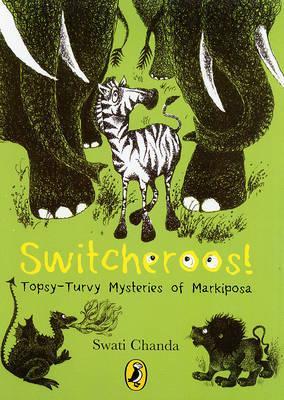 Switcheroos! Topsy-Turvy Mysteries of Markiposa
Switcheroos! Topsy-Turvy Mysteries of Markiposa
Swati Chanda
Illustrated by Ajanta Guhathakurta
2007, Puffin Books India
135 pages, fairy tale, kids, humor
FOUND: Starmark, Mani Square Mall, Kolkata
In this collection of children's stories, we meet the furry and feathery inhabitants of Markiposa. The main character, Rinzin, is a small green dragon with orange spots who, despite being vegetarian, has no friends - because a terrifying ball of flames streams from her mouth every time she tries to say hello! After a friendly rabbit figures out a solution to this fiery little problem, Rinzin establishes herself as the go-to problem solver for the whole forest. So when the lion prince loses his roar or a crow turns rainbow colored, they always go straight to Rinzin to find a solution. And the clever dragon often knows what to do- or, more specifically, often knows
who will know what to do and where to find them.
I had to buy this book after reading the back cover in a bookstore. My expectation was that it would be funny and cute. I was not at all disappointed. Not only do these stories channel some of the cleverness of the
Winnie-the-Pooh stories, but they also deal with issues that are important for children (and adults!) to think about.
For example, in one of the stories some young monkeys decide that they do not want to "monkey around" like they're supposed to. No, instead of throwing rotten mangos at people, they prefer to sit and ponder the Great Mysteries of the Universe. The leader of the group goes to Rinzin to complain about how these young monkeys are throwing tradition out the window. Rinzin doesn't quite see the problem with the young monkeys thinking and spending time in serious interests. But she agrees to talk to them and see what is up. In the end, they discover that there was an external reason for this personality change, and the monkeys are cured.
What can people learn from this story? First, that it is ok to do things that are different that what you are expected to do - even if your parents (or other adults) are unhappy about it. Rinzin doesn't really see the need to "fix" things; instead of forcing them to change, she lets the children express their opinions. This is the right way to deal with this kind of issue. But then she discovers that the monkeys' personality change is hasn't come from within them; it is a result of an external aspect of the environment. Because the monkeys' personality was changed through an external force, it is important to try to cure them. She searches for a solution and in the end they go back to their normal, carefree selves.
In another story, many of the meat-eaters of the forest have become converted to vegetarianism. While Rinzin is rather thrilled by this idea (she doesn't like the idea of animals eating other animals), she understands the problem that will arise: unfortunately, meat-eaters cannot get their proper nutrition from eating grass. So she tries to find the reason why they have suddenly converted, and finds that they were tricked into doing so. Because tricking others into doing something - even into doing something that we think is morally correct - is wrong, Rinzin solves the problem and the meat-eaters go back to eating meat. Although this may not be ideal from Rinzin's perspective, she would not condone forcing or tricking someone into doing something they don't want to do.
The one downside of this book is that it seems strangely incomplete, as if there should have been at least one more story. A traveler from far away, the winged unicorn Nash-4, appears in two of the stories, but his story is never told. How did he get to this forest? Why does he eat snakes? How will he get back home? To make this a truly classic work of children's literature, these questions would have needed to be answered.
All in all, though, this is an adorable children's book that has not gotten enough attention. I highly recommend it for both kids and adults, especially if you like the clever innocence found in the Winnie-the-Pooh stories.
Switcheroos! is available from Amazon US, Amazon UK, Amazon IN, and flipkart.
Want to see more reviews of world literature and film? Follow me on twitter or like The Globally Curious on facebook to see updates!
 Sirena Selena
Sirena Selena



